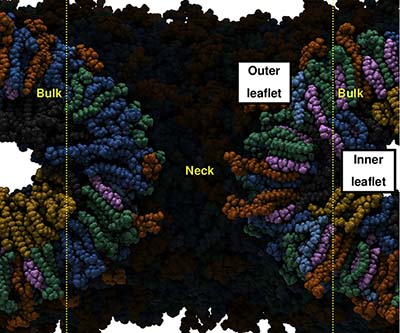
Labeled illustration of a pore in the cell membrane. Credit: Sodt Lab, NICHD
Biological membranes are composed of two layers of phospholipids (a molecule that is part salt and part fat) with embedded proteins. Both proteins and lipids play key roles in enabling large substances to enter and exit the cell by promoting formation of membrane fusion and fission pores—structures that connect two lipid membranes. The lipids in the membrane can bias pores toward expansion or closure, modifying the work done by proteins. The physics of these interactions directly influence processes related to disease, such as the ability of viruses to penetrate and bud from cells.
Researchers in the Sodt Lab use computational techniques to determine how membrane composition and lipid chemistry influence membrane properties. One of their recent studies sought to understand why cholesterol, a lipid component that stiffens membranes, also supports uptake of substances into the cell. Each layer that makes up the membrane’s lipid bilayer has a different composition. Cholesterol’s ability to rapidly flip between the layers makes it uniquely suited to relieve stresses during membrane reshaping.
The study demonstrated that cholesterol is depleted in the “neck” of the pore, where the membrane is inherently thinner, suggesting that that membrane thickness influences cholesterol distribution more than membrane curvature. The results suggest that cholesterol drives pore constriction or closure, indicating that cholesterol accumulation favors processes that require small pores, such as viral entry into and budding from the cell. This knowledge improves understanding of fusion pores on a molecular level.
Learn more about the Physical Biology and Medicine Group: https://www.nichd.nih.gov/about/org/dir/affinity-groups/PBM
 BACK TO TOP
BACK TO TOP